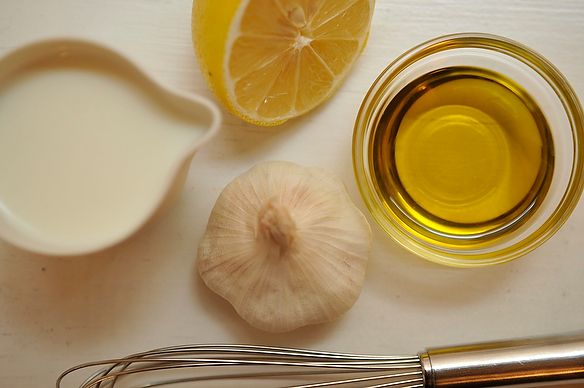
A New Way to Dinner, co-authored by Food52's founders Amanda Hesser and Merrill Stubbs, is an indispensable playbook for stress-free meal-planning (hint: cook foundational dishes on the weekend and mix and match ‘em through the week).
Order nowPopular on Food52
Continue After Advertisement
55 Comments
darksideofthespoon
May 8, 2013
Oh wow. I'm making the Smoked Lentil Salad right now and only just noticed our Mayo jar is scraped clean. This is a wicked replacement! Magical how it thickens!
sstratmann
October 13, 2010
so, this is probably a very dumb question, but beyond being deeelish, is this also a good lunch-box sandwich mayo? i'm desperate to find a way to send mayo on the sandwiches for my kids, without poisoning them. seems this may be OK...?
mountainchef
February 8, 2010
Hi Yalda,
Can you enlighten Me and Amanda as to what a Salad Olivier consists of?
Can you enlighten Me and Amanda as to what a Salad Olivier consists of?
Kym9932
February 7, 2010
a side about mayo and eggs. If possible get eggs that have been laid the day you buy them and have never been refrigerated
that is the real important part. Once the egg has been refrigerated then it starts to die, but if never refrigerated then it just hangs out waiting to be sat on, because of course the egg still says alive because it wants to be a chicken.
I've kept mayo for three weeks using only fresh laid eggs...but I'm no Scientist, just IMHO
that is the real important part. Once the egg has been refrigerated then it starts to die, but if never refrigerated then it just hangs out waiting to be sat on, because of course the egg still says alive because it wants to be a chicken.
I've kept mayo for three weeks using only fresh laid eggs...but I'm no Scientist, just IMHO
Kym9932
February 7, 2010
I love the sound of this mayo also, but question
why can't you do it in a food processor and use the plunger (which has a hole in it) to pour in the oil?
why can't you do it in a food processor and use the plunger (which has a hole in it) to pour in the oil?
Amanda H.
February 8, 2010
David Leite says you can do it in a mini food processor. I think the idea is that the liquids need to be emulsified on high speed in a compact area and in a large food processor, the milk and oil would get flung around too much. But I haven't tried it, and it may be worth testing it at least once.
mountainchef
February 7, 2010
Love the sound of this Mayo. Am also intrigued by the Salad Olivier some folks have mentioned. What is this?
campagnes
February 7, 2010
I can't wait to try this, but a quick question first: You specify using a blender or immersion blender - do you think this would work with a high-powered food processor? I don't have either blender, unfortunately. Thanks for sharing this!
dawnviola
February 7, 2010
I'm so excited to be reading this because I'm allergic to soy and can't buy prepared mayos...and making mayo myself is sometimes not high on my list of ways to use an egg yolk. I'm glad to see this alternative.
But, knowing what I know about emulsions, how does this stay together without separating for up to a week?
I may have to give it a try and see :-)
But, knowing what I know about emulsions, how does this stay together without separating for up to a week?
I may have to give it a try and see :-)
Amanda H.
February 8, 2010
I probably shouldn't have included that storage detail because I haven't tried it myself, but that is what David Leite says.
DianneV
February 6, 2010
I had this in Madrid with Spanish Tomato Toast (pan con tomate) and have wanted to duplicate it .I knew it wasn't quite aioli--I think this recipe solves the recipe puzzle. Thanks!
Amanda H.
February 10, 2010
Interesting -- in some ways it's more versatile than mayo because it's lighter/cleaner.
clotilde
February 6, 2010
For me, part of the appeal is that a milk-based mayo should keep a lot longer: when I make a classic mayo in my household of two, it's a real challenge to use it up before we feel it's no longer safe to eat, because of the raw egg yolk.
Yalda
February 6, 2010
I'm with you Azita, this will be great in Salad Olivier.
Mayo is one of those condiments that is so versatile in my kitchen and the whole family loves it, so it'll be a real culinary coup if I can nail a good homemade version. I'm going to give this a try this week.
Mayo is one of those condiments that is so versatile in my kitchen and the whole family loves it, so it'll be a real culinary coup if I can nail a good homemade version. I'm going to give this a try this week.
Veronica
February 5, 2010
Amanda--absolutely delicious and even easier to make than it sounds. Going to serve with seared tuna tonight. Thanks so much, again!
Amanda H.
February 5, 2010
I can't believe you made it already -- how cool! And I love the idea of it with seared tuna. I'm going to have to try that. Have a great dinner.
Veronica
February 5, 2010
Thank you, Amanda. This sounds too good to be true! And a great story to go with it. Can't wait to try, so heading for the kitchen...now!
Azita
February 5, 2010
Thank you so much for this recipe. I've been looking for a recipe like this since I started making salad olivieh . It's just perfect!
Amanda H.
February 5, 2010
Great, enjoy! And I think David Leite includes other variations in his book, The New Portuguese Table -- check it out, if you have a chance.
SueonFood
February 5, 2010
If I had some whole milk in the house, I would make that this very second. It sounds like a revelation. I wonder if I could mix heavy cream with 1% milk. I find it odd, though, that the recipe doesn't use ALL olive oil.
Amanda H.
February 5, 2010
That seems worth trying. I talked to David Leite about the oil, and he thinks that olive oil is just too strong and heavy. And it makes sense to me -- when I make regular mayo, I always do half vegetable (or peanut) oil and half olive oil.


See what other Food52 readers are saying.